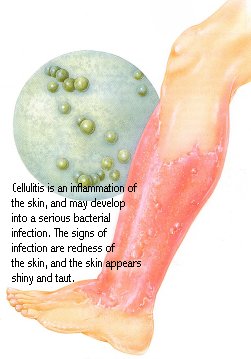Big C Discount Drugs Health Information
Cellulitis

Antibiotics Will Treat Infected Skin
Cellulitis is an inflammation of the skin and connective tissue under the skin. It usually appears after a break in the skin allows bacteria to enter the body. A serious infection may then result from this bacterial invasion. Once infected, the tissues surrounding the infected area become swollen. The swelling of the tissues around the infection causes the area to become red, hot, painful, and the skin appears shiny and taut. In more serious cases of cellulitis, there can be signs of infection throughout the body, such as fever, sweating, shaking chills, and muscle aches. If cellulitis is treated early, it can be cured with oral antibiotics. If the infection is more severe and has moved deeper into the tissue or even to the bone, hospitalization and an intravenous antibiotic may be needed. In some cases, when the infection has continued for a long time or has occurred in diabetic patients or other patients with poor circulation, or in patients with poor immune systems, surgery may be needed to remove dead tissue before the infection can heal completely.
Cellulitis is caused by bacteria that invade the tissues beneath the skin as a result of a skin wound. If not treated properly with antibiotics, serious complications, and even death, can result.
A Deep Skin Infection
Cellulitis is caused by a bacterial infection in the tissues beneath the skin. Normally, skin is covered with bacteria, but the bacteria do not cause an infection because the skin layer protects the underlying tissue and bacteria are prevented from entering the body. If there is a break in the skin, however, the underlying tissue is exposed to bacteria, and cellulitis may then occur. This means that any break in the skin, from an animal or insect bite, cut, scratch, or any other wound, can be the beginning of a bacterial infection and cellulitis. Cellulitis can also develop in patients with diabetes, individuals with poor circulation, in those who are taking immunosuppressive drugs or have poor immune system function due to disease, or those who have recently undergone a heart, lung, or dental procedure. Most cases of cellulitis accompany an infection from streptococcus or staphylococcus bacteria. Cellulitis can develop anywhere tissues are infected, but the most common sites are the legs and face.
Oral or Intravenous Antibiotics: The symptoms of cellulitis often begin as a redness and swelling in ihe area of a break in the skin, but cellulitis can also occur wherever there is a tissue infection even if no break in the skin is seen. The area is painful to touch, and the skin stretched over the swollen tissue looks shiny and tight. There may be a rash over the area, or a thin red line that runs along the skin over the infected tissue. Symptoms of fever, muscle aches, shaking chills and sweats, and headache can be seen in some cases. The diagnosis of cellulitis is made based on a physical examination. Laboratory tests may show a high white blood cell count or bacteria in the bloodstream. The treatment for cellulitis includes an oral or intravenous antibiotic to control the infection, and pain medication if necessary. Often, since cellulitis occurs in the lower extremities, the infected area is kept raised to reduce swelling. In the treatment of long-standing or recurring cellulitis, especially in patients with diabetes or immunosoppression, hospitalization may be required to control the infection. Most bacterial skin infections improve quickly after a few days of antibiotics, but it is always important to finish the entire course of antibiotics for a complete cure.
Serious Complications Can Result: If cellulitis is not treated effectively with antibiotics, complications such as an infection in the bloodstream (sepsis), or inflammation in the brain (meningitis) or lymph system (lymphangitis) may develop. Gangrene, a condition in which infected tissue dies, is another complication of serious, untreated celluiitis. Cellulitis can be prevented by cleaning the area thoroughly when a break in the skin occurs and keeping it clean until it is healed. Cuts, wounds, stings, and bites should be watched carefully for signs of infection while they are healing. Patients who are diabetic, immunosuppressed, or have poor circulation should be especially careful to inspect their skin for signs of infection or swelling on a regular basis. If you suffer an insect or animal bite, or a wound that causes a break in the skin, be sure to keep the area clean and protected until it is completely healed. If any area with a break in the skin begins to show signs of redness, swelling, warmth, or pain, see a physician to evaluate the area for infection. Ask your pharmacist if you have any questions about the antibiotics or pain medications used to treat cellulitis.
